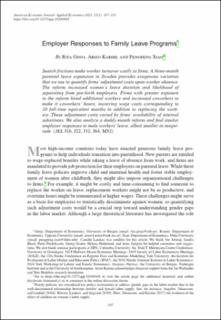| dc.contributor.author | Ginja, Rita | |
| dc.contributor.author | Karimi, Arizo | |
| dc.contributor.author | Xiao, Pengpeng | |
| dc.date.accessioned | 2023-02-27T14:00:26Z | |
| dc.date.available | 2023-02-27T14:00:26Z | |
| dc.date.created | 2022-01-05T10:42:39Z | |
| dc.date.issued | 2023 | |
| dc.identifier.issn | 1945-7782 | |
| dc.identifier.uri | https://hdl.handle.net/11250/3054342 | |
| dc.description.abstract | Search frictions make worker turnover costly to firms. A three-month parental leave expansion in Sweden provides exogenous variation that we use to quantify firms' adjustment costs upon worker absence. The reform increased women's leave duration and likelihood of separating from pre-birth employers. Firms with greater exposure to the reform hired additional workers and increased coworkers to make it coworkers' hours, incurring wage costs corresponding to 10 full-time equivalent months in addition to replacing the workers. These adjustment costs varied by firms' availability of internal substitutes. We also analyze a daddy-month reform and find similar employer responses to male workers' leave, albeit smaller in magnitude. | en_US |
| dc.language.iso | eng | en_US |
| dc.publisher | American Economic Association | en_US |
| dc.title | Employer Responses to Family Leave Programs | en_US |
| dc.type | Journal article | en_US |
| dc.type | Peer reviewed | en_US |
| dc.description.version | publishedVersion | en_US |
| dc.rights.holder | Copyright 2023 American Economic Association | en_US |
| cristin.ispublished | true | |
| cristin.fulltext | preprint | |
| cristin.fulltext | preprint | |
| cristin.fulltext | original | |
| cristin.qualitycode | 2 | |
| dc.identifier.doi | 10.1257/app.20200448 | |
| dc.identifier.cristin | 1974948 | |
| dc.source.journal | American economic journal. Applied economics | en_US |
| dc.source.pagenumber | 107-135 | en_US |
| dc.identifier.citation | American economic journal. Applied economics. 2023, 15 (1), 107-135. | en_US |
| dc.source.volume | 15 | en_US |
| dc.source.issue | 1 | en_US |
